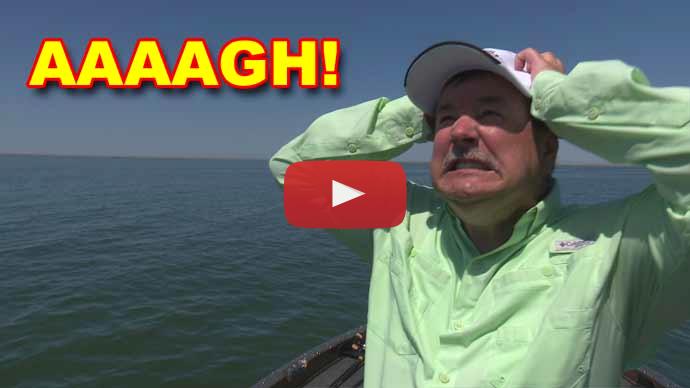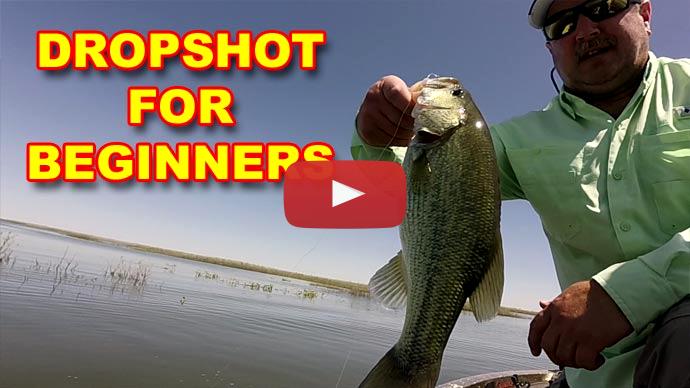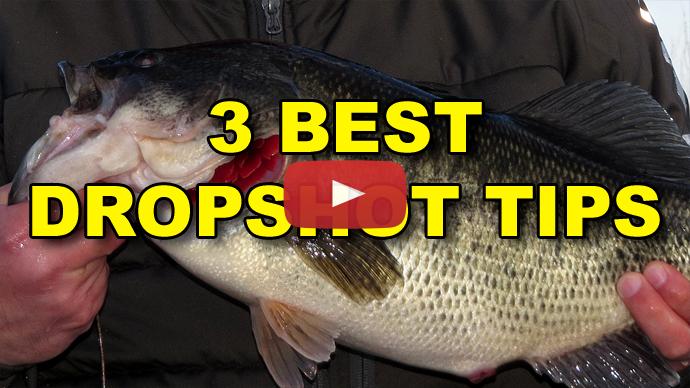Hey, guys. Cliff Pirch here today, and we're talking on bassresource.com about drop shotting in the wintertime. So drop shot really works year-round. There's different applications year-round. In the wintertime, you've got fish that are just a little bit more lethargic. And so it's a good technique to put the bait in the strike zone wherever they're at and give them some time to bite it.
When this thing first came out, I had a little area where I was fishing in the wintertime and some local tournaments, and it was hard to catch those fish. You couldn't get them to react too much. And when this thing came out, you pitch it out there, drop it into those deep rocks and shake it for a while. They finally just couldn't take it, and they grab it. It's an easy meal for them. Looks vulnerable, so it's a great technique for that wintertime bite.
I know lots of folks are familiar with the drop shot rig, but just to give you some specifics, what it is, is I'm taking and suspending a bait up off the bottom. I've got a weight that anchors it to the bottom and my bait ends up being just up off to where it just kind of keeps it in that strike zone.
Wintertime fish, they're not typically gonna move far to get your bait. Their metabolism is slower, so you wanna target those specific spots where the fish are at and give them a good chance to bite it. They may not run out and move too far to get it. So a drop shot works really well for that. I don't have to do a whole bunch to impart action. I might just give it a little bit of a shake, keep some movement on there to get their attention. But in general, I don't have to drag it down the point or wind it like a crankbait or spinnerbait or anything like that.
So it's gonna be a good technique to really put it in their face and keep it there. And a lot of times they won't bite it right away. It depends on where you're at in the country. And wintertime means different things in different parts of the country. I'm from the southwest Arizona. We can fish year-round and we've got really pretty good wintertime fishing. There might only be, like, two weeks where they don't really bite much around Christmas, and they may bite all through the winter some years. So we've got a pretty good winter fishing season and this is just a great way for us to fish down there.
And it's good for lots of parts of the country when the fish slow down a little bit. But where we live, I'm gonna be targeting some offshore rocky breaks, deep points, deep ledges, things like that, maybe bluff walls. A lot of times they will get on that vertical stuff because they don't have to swim far to change depths if the water level changes. There's not a lot of... They don't they travel a lot. And so, if it's a nice sunny day, they might come get up a little bit further off of it, or they might get down to the base of those rocks for a little bit more of that dark, comfortable cover for them. So bluff walls are a great place to target with a drop shot as well.
And I'm not fishing it all the way down the wall a lot of the times, I might find a crack in the wall where there are some rocks have fallen off and created a little ledge on the wall, and that usually holds fish, especially in the winter. So, I might pitch it on a wall or a crack in the wall until it falls and hits a ledge, fish it at that ledge until I get a bite. And when you get the evidence, you'll kind of figure out what depths to target, what areas seem to be working best. But again, it's a great wintertime technique. I'm just suspending that bait down in the strike zone.
I still like to use my little straight tail worm most of the time. Some guys like to use a crawl or a creature bait or a stick bait, but in general, I really love sticking with just a straight tail worm. Coming from out west, we always fish little soft hand pours, a lot of natural colors, and a real subtle straight tail worm.
This is a new one from Big Bite Bait, so we're excited about. We've been working on it over the last year. It's a new signature worm of mine called the Cliff Hanger. And they're making it with the new Scentsation soft plastic. And what that is, it's just a really, really heavy scented bait. So not only do I get the real softness, it's really, really soft. You can see it just basically falls off. And it's a soft bait to where you can use that little light wire hook and make sure you know that they're gonna get the hook when you set the hook. And it's very buoyant and I get to add that scent to it. So it draws those fish in sometimes, especially if you're fishing a spot slowly in the wintertime.
Smallmouth, especially, they're really drawn to scented plastics or scented baits. So it really helps with a smallmouth bite, but it also does well with spotted bass and largemouth. So new Cliff Hanger worm from Big Bite Baits, something I like using.
You've got to experiment with colors. A lot of times I go with the natural greens and the real natural colors, the green pumpkins and watermelons. There's a really cool one here called Natural Magic that they've got. It's just a kind of a light clear green worm and it's got a little blue shimmer on the bottom half of it. So it's a real nice, natural looking color. That's a good one, but you also kind of need to let the fish tell you what's working best. You've got a couple of guys fishing in the boat, one guy maybe has a green pumpkin, one guy has a pink worm and another one might have purple or something, so, you've got to see what seems to be working best.
And again, one day, if it's bright and sunny, one color might work well. Another day, if it's dark and cloudy, you might need to go with a darker color, with a black, with a purple, and they've got a real nice black Cliff Hanger worm. So you've got to experiment with those colors to see what kind of evidence they give you.
The new electronic age, you can really see what's down there. So watch those depths where you start seeing what looks like bass hanging on the bottom, hanging on the wall. Look for those areas to target. That gives you a lot of confidence. When you cast there, you can see your bait go into the strike zone, really helps you cut down on wasted time. You know that you're putting your bait in the strike zone. So that's another good thing about that drop shot in the wintertime. You know that you're getting right into their face. It's a good vertical technique dropping straight down on your sonar when you see them, but again, with the new stuff that you can see out there with, you can also cast to targets and see where specific fish are at. So it's something I really like to use in the winter.
Clarity wise, we've got a lot of clear water out west. You may not, you may be fishing shallower dirtier water. You can get away with a little heavier line, maybe a medium wire hook. A lot of places where we're at, I'm fishing it on light line. I've got, like, eight-pound fluorocarbon, I've got a light wire Gamakatsu, we're not light wire hook on here. This is a Phenix medium action or medium light action drop shot rod. I like the 7'6". Some guys might like 6'9", 7'2", things like that, just depends. I like the longer rod because when I get a bite, if there's any bow or any current in my line, I can move more line that way. But you wanna make sure it's a soft rod. You're talking about light line, you don't wanna really crack them and have the potential to break your line, so it needs to be a soft rod.
Your hook set is basically a reel into them and bow up. You don't need to take two steps back and clobber them. It's reel into them as it tightens up and bow up on them. Make sure you've got good pressure in there and keep that rod bowed while you're fighting them.
And light line, make sure that drag is loose. You get a big one on, he might start coming to the boat and kind of tricky a little bit. And you think, "Well, I got him." He sees the boat or kind of figures out he's hooked, might make a hard run. So you always wanna be checking that drag. Make sure that when it pulls, it can come off the rod without breaking the rod. If he makes a surge, that light line, it's more important to really know where your drag's at on that.
When I set the hook, a lot of times I want that drag tighten down just enough to barely hear that drag squeal just a tiny bit at the end of your hook set, and that's usually a good balance to manage your drag at that level.
So those are some tips for drop shotting in the winter. Good way to get bites, good way to catch big fish. If you find an area that's just holding big fish, you can target them, but fun way to fish. And again, you can have some great action. You may not have the 50 fish days that you might have in the summer, in the fall, in the spring, but you might have some real good action. You might catch 12 fish, you might catch 17. It's a great way to just get those bites when conditions are a little bit tougher. They're not feeding a lot. This is a really good way to get them. So again, it's something I use year-round, but the winter time, it does excel because you're putting it in the strike zone. They're not willing to travel too far to get it, so it's a great technique to get them.
So I hope that works well for you. I hope you're able to fish in the winter. Like some places, we're here on the Mississippi River today, it's frozen out here. So you're probably drilling holes and fishing a little differently out here. But where I'm from, in the southwest, we fish in the winter and a lot of these folks migrate down there to fish with us. So that's a technique that'll work for you. And I hope you get them this winter.



